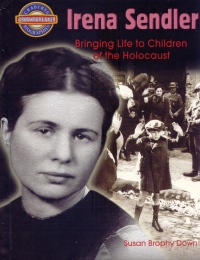| ________________
CM . . . . Volume XIX Number 15 . . . . December 14, 2012
It is said that war brings out the very best and the very worst in humanity. Susan Brophy Brown writes about Irena Sendler, a courageous and fearless young woman who worked with others at the risk of their own lives to help save Jews from the Nazis in Poland during World War II. Sendler is one of the best examples of humanity one could hope for-a mixture of a simple and direct belief in helping others with a sophisticated understanding of the complexities of a society tearing itself apart. Brophy's book, in unvarnished yet descriptive prose, gives the reader a clear sense of Sendler as an individual who was shaped by the values of her family:
Brophy's book provides the reader a brief, but broad, overview of Europe's economic, social, and political environment prior to and after World War II. The rise of Hitler and the ripple effect of his policies on the Jews of Europe, specifically in Poland, are gently but firmly written about by the author. Woven through Brophy's text is Sendler's life story. Idealism can be perceived as a valued but unrealistic trait in the harsh light of war. Sendler's innovative organizational and networking skills, honed by her work as a social worker, enabled her to develop, along with others, ingenious means to hide and transport Jews to safety, thereby giving her idealism weight due to her practical and shrewd mind (p. 32):
Discussions of historical events can be dry lists of names, dates, and political issues. Irena Sendler effectively uses black and white archival photographs to illustrate the stark and brutal consequences of the Second World War for Europe and on Jews who were interned in concentration camps or who suffered in the Warsaw Ghetto. The design of the book emphasizes quotes from Sendler and others as well as facts about events and individuals through the crispness of white and black text set on white, black, and grey backgrounds. Black and grey bands frame the borders of text and pages in the book. The effect is of grim documentation, created layer by layer, of the social, psychological, and economic consequences of war. An example of this is found in the black and white photograph of a young girl, hands spread wide, mourning over the body of her equally young sister. The accompanying quote sets the context for the image:
The images and discussion in the book are frank and sometimes gruesome. Consideration of the sensibilities and sensitivities of young readers is advised. The images serve a purpose, as do the facts presented in the book, as they underline the conditions under which Sendler and others operated. Fear, the need for discretion and secrecy, perseverance; and the ability to serve higher ideals in the face of possible death characterized Sendler's actions as well as others who worked to save the Jews of Poland. The book is well organized without giving the appearance of being rigidly structured. With a young readership in mind, information is introduced in easy to read "chunks" of text highlighted with various types of font that are creative without being overly decorative. One person's life, Sendler as a young and old woman and the rediscovery of her efforts through the efforts of Kansas high school students, draws the reader through the overwhelming events of World War II and into the world in which we live today. The grim content is balanced with examples of bravery and innovation, hope and success. A chronology, glossary, and additional information are available for further discussion. Irena Sendler: Bringing Life to Children of the Holocaust would be an asset to a variety of courses including social studies, sociology, psychology, history, economics, and design. Highly Recommended. J. Lynn Fraser, a freelance writer whose articles appear in national and international magazines, is also the author of a nonfiction book for children. She is currently writing a fiction book for adults and a nonfiction children's book.
To comment
on this title or this review, send mail to cm@umanitoba.ca.
Copyright © the Manitoba Library Association. Reproduction for personal
use is permitted only if this copyright notice is maintained. Any
other reproduction is prohibited without permission.
NEXT REVIEW |
TABLE OF CONTENTS FOR THIS ISSUE
- December 14, 2012.
AUTHORS |
TITLES |
MEDIA REVIEWS |
PROFILES |
BACK ISSUES |
SEARCH |
CMARCHIVE |
HOME |
